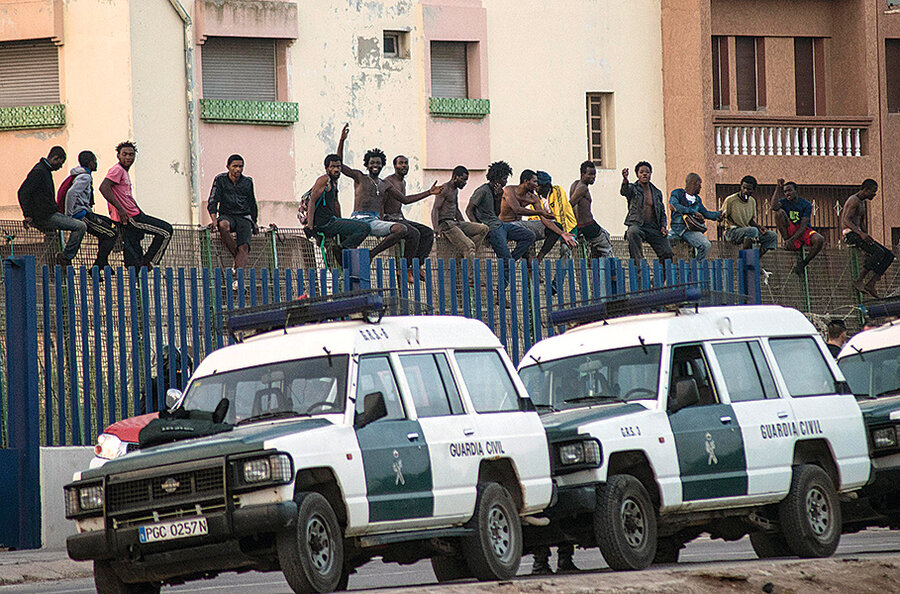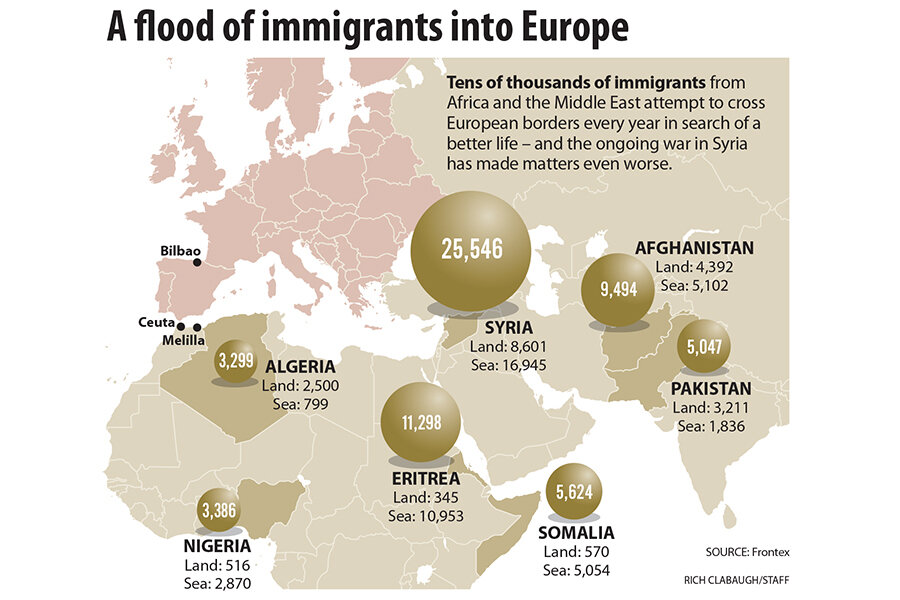African passage to Europe: two brothers, two paths, two struggles
Loading...
| TANGIER, MOROCCO; AND BERLIN
Ibrahima Yalou and Abdou Ndiaye are half brothers from a small town in central Senegal. Tall, strong, and bearing the same wide smile, they grew up sleeping in the same bed. Both left home to escape poverty, traveling by land across three countries with the hope of eventually making it to Europe. After multiple attempts at crossing from Morocco into Spain, only one of them has made it in.
It was not until his sixth attempt – or “strike,” as they are called – that Mr. Yalou made it to Spanish soil. Under the cover of night, he rowed across the border in an inflatable dingy with 18 others, including one infant. Mr. Ndiaye was not on the boat that night; worn out by past strikes, he was working to save money for the next one.
Today, Yalou is part of Spain’s undocumented migrant class, working as a street seller in Bilbao. Ndiaye also works as a street seller, but in a market on the outskirts of Tangier, Morocco. They haven’t seen each other in years.
But they joke about being in the same situation on two different continents: Both are undocumented and, lacking the right to work, both survive by working in informal economies, sending whatever they can spare back to their family in Senegal.
Between them, the brothers mark both ends of a passage into Europe that is traveled by tens of thousands of migrants every year, and in increasing numbers, as they flee poverty and war in the Middle East, Africa, and Afghanistan.
Their plight has become a political lightning rod, with the rise of far-right, anti-immigrant parties in Europe at a time of record unemployment. And the influx has pitted southern European countries – such as Spain, Greece, and Italy, which are seeing the highest number of undocumented migrants entering – against northern Europe, which assimilates most asylum seekers.
“There has been an overall chill across Europe amongst policymakers, politicians, and publics towards immigration and asylum policy,” says Elizabeth Collett, director of the Migration Policy Institute Europe.
'Strike by boat or foot'
In northern Morocco, migrants strike by boat or by foot, hoping to enter Spain across the Strait of Gibraltar or by scaling the 20-foot border fences into Ceuta or Melilla, two Spanish enclaves in North Africa. Recently, groups of migrants have become more organized, storming the two cities in groups numbering in the hundreds. During a two-day span in August, more than a thousand people tried to climb the barriers around Melilla. Fewer than a hundred succeeded.
Yalou and Ndiaye (both pseudonyms) have made many attempts at the border. Yalou had previously attempted rowing and climbing into Melilla, swimming into Ceuta, as well as rowing the nine miles from Morocco to the Spanish mainland. Each time, he was caught and sent back to Morocco by one of the two countries’ police forces.
When he did finally arrive in Melilla, Yalou was ecstatic. Because he had reached the European Union, Yalou had the right to a lawyer and an interpreter, and to live in the Spanish enclave while his immigration case was processed. He stayed in a crowded-but-clean bunk room in the city’s temporary immigrant center (CETI, its acronym in Spanish) where he was given three meals a day, medical attention, and Spanish classes.
Still, Melilla felt like a large prison, Yalou says, adding that at least in Morocco he had some freedom of movement. The CETIs are open and migrants can leave during the day, but they are not able to leave the cities of Ceuta or Melilla, neither for the Spanish mainland nor to go back to Morocco.
Unable to work in Ceuta or Melilla, groups of migrants can be seen roaming the streets and beaches of both cities. Some wash or help park cars for a few spare euros. Residents say the influx of people has been felt in these two small cities.
“They treat Ceuta like a buffer for the whole country and continent. I don’t understand why we have to bear the brunt of the entire country’s immigration policy,” says Jose, a hotel owner in Ceuta who only gave his first name. “They [the migrants] are driven by hunger in their countries. Let them pass through to Spain and France and Germany so they can work.”
20-foot fences
The CETIs were built more than a decade ago, at a time when, residents say, the borders were much more porous. Before they were built, migrants’ tents and camps dotted the hillsides on the Spanish side of the Ceuta border; these were their temporary homes for the months or years it took the Spanish bureaucracy to churn. In Melilla, the border area was one of the best playing fields in town for soccer, recalls one resident, adding that a lost ball meant hopping into Morocco over a waist-high fence to retrieve it.
But today, 20-foot fences separate the enclaves from their African neighbors, as the flow of immigrants has gone from a stream to a torrent. In Ceuta and Melilla, Spanish and Moroccan police have been under intense criticism for their heavy-handed responses to migrants trying to cross the border. The situation came to a fever pitch in February, when the Spanish military police fired rubber bullets at a group of migrants numbering in the hundreds, as they tried to swim across the border to Ceuta. Fifteen died in the chaos, generating fury from human rights activists and the EU.
Still, for many migrants, it’s worth the risk. While the law is not always followed, and Spain has been criticized for its summary deportations, often violent, in theory the migrants cannot be deported without legal proceedings or the opportunity to apply for asylum, says Virginia Álvarez, head of Home Affairs for Amnesty International in Spain.
Migrants’ cases, however, can often take months or years to resolve, depending on their country of origin and whether or not they apply for political asylum, explains Sara Verdú, a lawyer who works with Valencia Acoge, an immigrant advocacy organization on the Spanish mainland.
Migrants who do not apply for asylum often receive safe passage to the Spanish mainland to relieve overcrowding, Ms. Verdú says. Those who apply for asylum, she adds, “almost never make it to the [Iberian] peninsula.”
Spain is not alone in facing the brunt of the migration to Europe today. Migrant deaths off the coast of Italy have become disturbingly commonplace: The most tragic incident occurred last October when 362 migrants drowned off the coast of Lampedusa.
In the wake of Lampedusa, Italy launched a rescue operation called “Mare Nostrum,” which costs the government $14 million a month. By the summer, the traditional “boat season,” Italian police and the Coast Guard had already rescued 60,000 migrants since the operation began in January. In all of last year, 42,000 people arrived.
Italy has repeatedly called for more support from the EU, which will overtake patrolling of the Italian border perhaps as early as November. “It’s not enough to have a common currency, a common presidency, or a common source of financing,” said Italian Prime Minister Matteo Renzi in June. “Either we accept the idea of having a common destiny and values ... or we risk the role of Europe itself.”
Europe divided
Spain has increasingly called on the rest of the EU to help, as have Italy and Greece. But northern European countries argue that they assimilate the majority of the continent’s refugees – and that southern Europe keeps conditions subpar to encourage migration to the north. Of the Syrians that received protection status last year, 60 percent were welcomed in two member states: Sweden and Germany. Germany in June granted asylum to another 10,000 Syrians, raising to 20,000 the number it’s accepted in a special program created since the conflict ignited.
Asylum seekers entering the EU are supposed to apply for refugee status at their point of entry to Europe, but they increasingly move on to other countries. The European director of the United Nations High Commissioner for Refugees, Vincent Cochetel, says family, better networks, or better access to jobs elsewhere prompts them to move on. In Italy, 27,000 people applied for asylum last year, compared with some 42,000 who were rescued, he says, or about half. “It is a sign of dysfunction of the system,” he says. “They are waiting for the next opportunity.”
Holger Kolb, a researcher at the Expert Council of German Foundations on Integration and Migration, says Germany is one of the top receivers of refugees today. “There is this assumption that there is a north-south divide, in which the south is receiving the lion’s share of migrants and the north is not [doing its share]. That is not true,” he says. “There are countries in the north, like Sweden and Germany, receiving many refugees. Italy, one of the countries that is very loud and direct about the burden they face, does not belong to the group receiving the most refugees.”
So far Europe hasn’t come to a common understanding.
“A solidarity system should be in place, Mr. Cochetel says. “But one is waiting for the other for a commitment.”
Trying again
In the meantime, the flows continue. Yalou says he was lucky in Melilla. He only lived in the CETI for a week before being placed on one of the government-organized flights to mainland Spain. Then, after two days in a police station, one month in an immigrant detention center, and a week in an immigrant shelter run by a nongovernmental organization, Yalou was free, but with no papers and nothing but bus fare to a city in the north of Spain and the clothes on his back.
This, migrants and activists say, is the Spanish government’s way of easing pressure on the whole system: Migrants are moved from the overcrowded CETIs to detention centers on the peninsula, and then are, in many cases, simply let go without any deportation procedure or any form of legal permission to stay. (The Spanish Interior Ministry did not respond to repeated requests for comment.)
Yalou was not discouraged: Spain has a clear path for undocumented migrants to sort their papers. Anybody living in Spain can register with the government as a resident, regardless of his or her immigration status. After three years of being registered and given a work contract, and having no problems with the police, Yalou can apply for regularization of his papers and the right to stay and work legally in Spain. And after 10 years with papers, he can obtain Spanish nationality, allowing him to live and work anywhere in the EU.
Still, Yalou says, slow Spanish bureaucracy and high unemployment make getting papers a long shot. And without papers, finding work is even more difficult. Yalou says he struggles just to survive here and often thinks about going back to Senegal.
Ndiaye, still living in a squalid building in the outskirts of Tangier, does not want to go back. Unfazed by the lack of work in Spain, he is determined to make it over, even though it’s a deadly gambit.
“If we don’t succeed, we come back and try again,” Ndiaye proclaims defiantly, “and if there’s no work in Spain, we’ll go somewhere else.”







